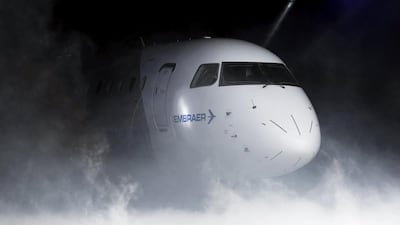Embraer, the Brazilian plane-maker and third largest aircraft manufacturer in the world, is in talks with Middle East airlines about rolling out its latest small-scale jet in the region, which may help regional carriers expand beyond the trunk routes that have fuelled their growth over the past two decades.
“We are between early and meaningful conversations with multiple carriers in the region,” John Slattery, chief executive of commercial aviation at Embraer said in an interview with The National.
The talks are “a combination of regional network carriers and subsidiaries of the larger flags, as well as the fast-growing low cost carriers”.
There is “significant” demand for the E2-family of aircraft that Embraer is currently developing, Mr Slattery said. The manufacturer expects the E2 to be certified within the next 80 days – “we are in the final 10-15 per cent sprint” before entering service in April 2018, he added.
_________________________
Read more:
Exclusive: Etihad bullish on future as carrier looks to reposition itself, refresh fleet
In boon to Boeing, Emirates orders 40 Dreamliners worth $15.1 billion
__________________________
Embraer expects to sign a deal to supply E2s in the Middle East within the next 12 months, with at least 350 E2s operating in the region over the next 20 years, Mr Slattery said. The projections are based on an estimated 5.8 per cent annual growth in air passengers over that period in the Middle East.
“We see significant appetite for the E2 in the region and are very optimistic [about a deal next year]. We believe [the E2] changes the dynamics of feed planning,” the chief executive said.
The three different types of E2 range from 75 to 150 seats. The aircraft could help both flag and low cost carriers in the region recover yields and revenues by developing an intra-regional model with more frequent services in smaller planes.
The Middle East has invested billions of dollars over the past 20 years to position itself as a global aviation hub that has transited traffic from east to west. However, yields have been negatively impacted over the past two years in the wake of a three-year oil slump and subdued growth globally.
“Look at the market today, yields are down about 10 per cent over the last 24 months, and when we look at intra- Middle East traffic – which is today mainly served by larger narrow-body craft – 48 per cent of intra-Middle East flights are travelling with less than 120 passengers, and 60 per cent of regional markets are served with a less than daily service,” Mr Slattery said.
“I believe we’re at the point where those airlines could consider more cost-effective intra-regional feed for the wide-bodies, and we are essentially creating an origin and destination market for the region.”
Mr Slattery pressed the case that it does not make financial sense for regional carriers to increase the number of daily services they provide given the types of planes they use.
“We’ve got to get away from this service with bigger aircraft and a less than daily service, to a two or three times a day service that will increase demand,” he said. “You can’t do that with the larger gauge equipment; it’ll kill you because the trip cost of an A320 neo is 20 per cent higher than that of an E2, whereas the seat mile cost is almost the same…The airlines here that are servicing these routes with larger gauge equipment are burning valuable dollars in the air.”
Sao-Paulo-based Embraer has around 10 employees in its Dubai office and hopes to expand this in line with demand, focusing on new sales, marketing and customer service staff.

